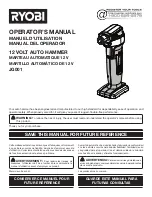
9
Recommissioning after repair
Wiederinbetriebnahme
Idrifttagande efter underhåll
Remise en service
E
Reconnect the tool to the air supply.
Check that no air leaks occur, either in operation
or at rest.
D
Das Gerät wieder an das Luftnetz anschließen.
Kontrollieren daß keine Leckage vorliegt, weder
im Betrieb, noch in Ruhestand.
S
Koppla verktyget till tryckluftsnätet igen.
Kontrollera att inget luftläckage förekommer,
varken vid drift eller i viloläge.
F
Raccordez l’outil de nouveau à l’air comprimé.
Vérifiez l’absence des fuites d’air, ou en service
ou en repos.
E
Charge the tool with short staples and try it at a
low air pressure: ~ 60 psi. Check that the driver
moves back.
D
Das Gerät mit kurzen Klammern laden und bei
niedrigem Luftdruck prüfen: ~ 4 bar. Kontrollie-
ren daß der Treiber zurück geht.
bar
S
Ladda verktyget med korta klammer och prova
det med ett lågt tryck: ~ 4 bar. Kontrollera att dri-
varen går tillbaka.
F
Chargez l’outil avec des agrafes courtes et essay-
ez le à une pression basse: ~ 4 bar. Vérifiez que
la lame de coup retourne.
E
Test the tool at 75 psi and check that the continu-
ous firing valve works smoothly at low speed;
thereafter at high speed.
D
Das Gerät bei 5 bar prüfen und kontrollieren ob
das Dauerfeuerungsventil regelmäßig arbeitet bei
niedrigem Tempo; danach bei hohem Tempo.
bar
S
Prova verktyget vid 5 bar och se efter om multi-
skottsventilen arbetar jämt vid lågt slagtal; däref-
ter vid hög hastighet.
F
Testez l’outil à 5 bar et vérifiez que la valve pour
coups multiples fonctionne régulièrement à
vitesse basse; puis à haute vitesse.
E
Install the tool on the work site and check that its
hose has the proper dimension – min. ¼".
D
Das Gerät am Arbeitsplatz installieren und die
Schlauchdimension prüfen – min. 6 mm.
∅
∅
∅
∅
6 mm (1/4")
S
Anslut verktyget på arbetsplatsen och kontrollera
att luftslangen har rätt dimension – 6 mm.
F
Installez l’outil au lieu de travail et contrôlez la
dimension propre du tuyau – min. 6 mm.
E
Adjust the air pressure to the lowest one that will
drive the staples to the desired depth. Start at
approx. 5.5 bar and raise this by 0.5 bar incre-
ments until the correct operating pressure for the
job in hand is found.
Never exceed 7 bar
. A low
air pressure will give low maintenance costs!
D
Stellen sie keinen höheren Luftdruck ein als für
das richtige Eintreiben der Klammern nötig ist.
Beginnen Sie dabei mit ca. 5.5 bar und erhöhen
Sie den Druck in 0,5 bar Stufen bis der richtige
Arbeitsdruck gefunden ist.
Gehen Sie aber nie-
mals über 7 bar hinaus
. Ein niedriger Druck
führt auch zu niedrigen Wartungskosten!
S
Ställ in lägsta möjliga lufttryck som fortfarande
driver klammern till önskat djup. Börja med
ungefär 5.5 bar och höj sedan trycket i steg om
0,5 bar tills det rätta arbetstrycket etablerats.
Överstig dock aldrig 7 bar
. Ett lågt lufttryck
bidrar till att hålla underhållskostnaderna nere!
F
La pression d’air est à régler au minimum né-
cessaire pour le travail à exécuter. Commencez à
environ 5.5 bar et augmentez chaque fois à pas de
0,5 bar pour arriver au résultat satisfaisant.
N’ex-
cédez jamais les 7 bar.
Une pression modérée
vous donne des frais d’entretien réduits!
4
5






























